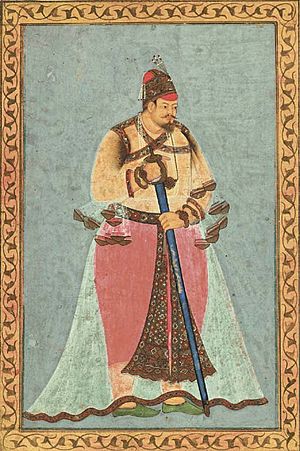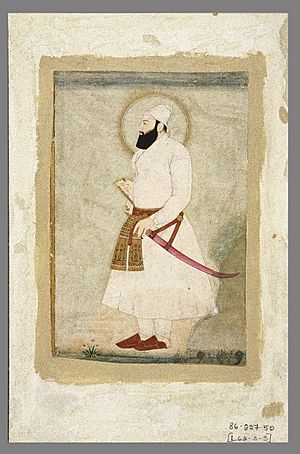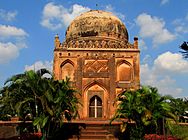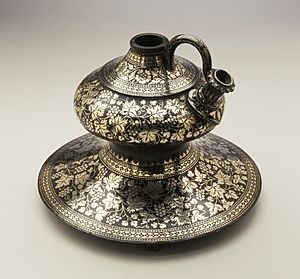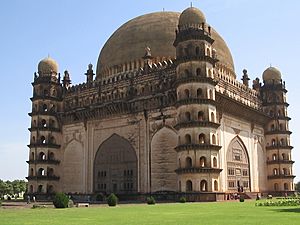Deccan sultanates facts for kids
Quick facts for kids
Deccan sultanates
|
|||||||||||||
|---|---|---|---|---|---|---|---|---|---|---|---|---|---|
| 1490–1686 | |||||||||||||
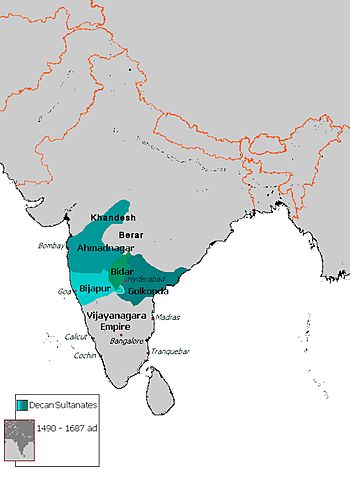
Map of the Deccan sultanates.
|
|||||||||||||
| Capital |
|
||||||||||||
| Common languages | |||||||||||||
| Religion | Islam | ||||||||||||
| Government | Monarchy | ||||||||||||
| Sultan/Shah | |||||||||||||
| Historical era | Late Medieval | ||||||||||||
|
• Established
|
1490 | ||||||||||||
|
• Disestablished
|
1686 | ||||||||||||
| Currency | Taka | ||||||||||||
|
|||||||||||||
| Today part of | India | ||||||||||||
The Deccan Sultanates were five important kingdoms in Medieval India. They were located on the Deccan Plateau, a large area in central and southern India. These kingdoms were ruled by Muslim leaders called Sultans.
The five sultanates were: Ahmadnagar, Berar, Bidar, Bijapur, and Golconda. They became independent around 1490, after a larger kingdom called the Bahmani Sultanate broke apart. Ahmadnagar, Bijapur, and Berar declared independence in 1490. Golconda followed in 1518, and Bidar in 1528.
Even though these kingdoms were ruled by Muslims, their founders came from many different backgrounds. Some were from India, while others came from places like Georgia or Iran. This mix of cultures made the Deccan Sultanates very unique.
The sultanates often competed with each other. However, they sometimes worked together, especially against the powerful Vijayanagara Empire to their south. In 1565, most of the sultanates formed an alliance and fought the Vijayanagara Empire in the famous Battle of Talikota. This battle greatly weakened the Vijayanagara Empire.
Over time, the Deccan Sultanates were gradually taken over by the powerful Mughal Empire. Berar was conquered in 1596, Ahmadnagar between 1616 and 1636, and finally Golconda and Bijapur were conquered by the Mughal emperor Aurangzeb in 1686–87.
Contents
Ahmadnagar Sultanate
The Ahmadnagar Sultanate was founded by Malik Ahmad Nizam Shah I. His father, Malik Hasan Bahri, was an important leader in the Bahmani Sultanate. After his father's death, Ahmad Nizam Shah became frustrated with the Bahmani rulers. He defeated their army in 1490 and declared Ahmadnagar an independent kingdom.
The kingdom was located in the northwestern part of the Deccan region. Its first capital was Junnar, but a new capital, Ahmadnagar, was built in 1494. Malik Ahmad Shah also captured the strong fortress of Daulatabad in 1499.
After Malik Ahmad Shah died in 1510, his young son Burhan became the ruler. Later, his son Hussain and grandson Murtaza also ruled. Murtaza Shah took over the Berar Sultanate in 1574. After Murtaza's death, there was a period of instability.
A famous figure from Ahmadnagar was Chand Bibi, an aunt of one of the young sultans. She bravely defended Ahmadnagar against a Mughal attack in 1596.
In 1600, the Mughals conquered Ahmadnagar and captured its ruler. However, a brave official named Malik Ambar continued to fight the Mughals. He declared a new sultan and moved the capital several times. Malik Ambar became the prime minister and a very powerful leader. After Malik Ambar's death, the sultanate eventually fell to the Mughals. In 1636, the Mughal viceroy of Deccan, Aurangzeb, fully took over the Ahmadnagar Sultanate.
Rulers of Ahmadnagar
- Malik Ahmad Nizam Shah I (1490–1510)
- Burhan Nizam Shah I (1510–1553)
- Hussain Nizam Shah I (1553–1565)
- Murtaza Nizam Shah I (1565–1588)
- Miran Nizam Hussain (1588–1589)
- Isma'il Nizam Shah (1589–1591)
- Burhan Nizam Shah II (1591–1595)
- Ibrahim Nizam Shah (1595–1596)
- Ahmad Nizam Shah II (1596)
- Bahadur Nizam Shah (1596–1600)
- Murtaza Nizam Shah II (1600–1610)
- Burhan Nizam Shah III (1610–1631)
- Hussain Nizam Shah II (1631–1633)
- Murtaza Nizam Shah III (1633–1636)
Berar Sultanate
The Berar Sultanate was founded by Fathullah Imad-ul-Mulk. He was originally from the Kannada region of India. In 1490, when the Bahmani Sultanate was breaking up, Imad-ul-Mulk, who was the governor of Berar, declared his independence. He established the Imad Shahi dynasty.
He made Achalpur (also known as Ellichpur) his capital. He also strengthened the forts of Gavilgad and Narnala.
After Fathullah Imad-ul-Mulk died in 1504, his son Ala-ud-din became the ruler. Berar often faced threats from the neighboring Ahmadnagar Sultanate. In 1574, a minister named Tufal Khan took over the throne from the young ruler Burhan. However, in the same year, Murtaza I, the Sultan of Ahmadnagar, conquered Berar and added it to his own sultanate.
Rulers of Berar
- Fathullah Imad-ul-Mulk (1490–1504)
- Aladdin Imad Shah (1504–1530)
- Darya Imad Shah (1530–1562)
- Burhan Imad Shah (1562–1574)
- Tufal Khan (usurper) (1574)
Bidar Sultanate
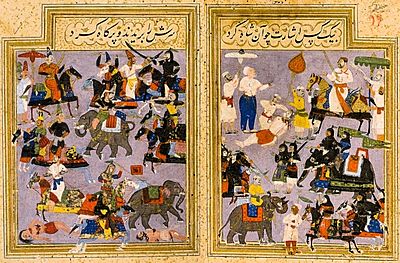
Bidar was the smallest of the five Deccan Sultanates. It was founded by Qasim Barid I. He started as a commander in the Bahmani Sultanate. By 1492, he became the real power behind the Bahmani ruler, even though the Sultan was still officially in charge.
After the last Bahmani ruler left Bidar in 1528, Qasim Barid's son, Amir Barid, became an independent ruler. Amir Barid's son, Ali Barid, was the first to use the title of shah (king). Ali Barid also took part in the Battle of Talikota. He was known for his love of poetry and beautiful writing.
The Bidar Sultanate was eventually defeated in 1619. It was then taken over by the Bijapur Sultanate, ending its rule.
Rulers of Bidar
- Qasim Barid I (1492–1504)
- Amir Barid I (1504–1542)
- Ali Barid Shah I (1542–1580)
- Ibrahim Barid Shah (1580–1587)
- Qasim Barid Shah II (1587–1591)
- Ali Barid Shah II (1591)
- Amir Barid Shah II (1591–1600)
- Mirza Ali Barid Shah III (1600–1609)
- Amir Barid Shah III (1609–1619)
Bijapur Sultanate
The Bijapur Sultanate was located in southwestern India. It was ruled by the Adil Shahi dynasty from 1490 to 1686. The founder, Yusuf Adil Shah, was a provincial governor under the Bahmani Sultanate. When the Bahmani state broke apart after 1518, Yusuf Adil Shah's successor, Ismail Adil Shah, created an independent sultanate.
The Adil Shahi rulers made their capital city, Bijapur, very beautiful with many grand buildings.
Ibrahim Adil Shah I changed some of the kingdom's policies. He focused on the local Indian Muslim identity and promoted Sunni Islam. He brought more local people into important government jobs.
The Adil Shahis often fought against the Vijayanagara Empire to their south. However, they also fought against the other Deccan sultanates. In 1565, four of the five sultanates joined forces to defeat Vijayanagara in the Battle of Talikota. After this victory, Bijapur gained control of some new territories. In 1619, the Adil Shahis conquered the Bidar Sultanate and added it to their kingdom.
Later in the 17th century, a new group called the Marathas started to revolt under their leader Shivaji. They captured large parts of the Bijapur Sultanate. The weakened Bijapur Sultanate was finally conquered by the Mughal emperor Aurangzeb in 1686, bringing the Adil Shahi dynasty to an end.
Rulers of Bijapur
- Yusuf Adil Shah (1490–1510)
- Ismail Adil Shah (1510–1534)
- Mallu Adil Shah (1534–1535)
- Ibrahim Adil Shah I (1535–1558)
- Ali Adil Shah I (1558–1580)
- Ibrahim Adil Shah II (1580–1627)
- Mohammed Adil Shah (1627–1656)
- Ali Adil Shah II (1656–1672)
- Sikandar Adil Shah (1672–1686)
Golconda Sultanate
The Golconda Sultanate was founded by Sultan Quli Qutb-ul-Mulk. He came from Persia (modern-day Iran) in the early 1500s and served the Bahmani Sultan. After the Bahmani Sultanate broke up, Quli Qutb-ul-Mulk took control of the Telangana region in 1518. He then declared his independence and took the title of Qutb Shah.
The Qutb Shahi dynasty ruled for 171 years. They were known for their rich diamond mines, including the famous Golconda mines. The kingdom was eventually conquered by the Mughal emperor Aurangzeb's army in 1687, after a long siege.
Rulers of Golconda
- Sultan Quli Qutb-ul-Mulk (1518–1543)
- Jamsheed Quli Qutb Shah (1543–1550)
- Subhan Quli Qutb Shah (1550)
- Ibrahim Quli Qutub Shah (1550–1580)
- Muhammad Quli Qutb Shah (1580–1611)
- Sultan Muhammad Qutb Shah (1611–1626)
- Abdullah Qutb Shah (1626–1672)
- Abul Hasan Qutb Shah (1672–1687)
Cultural Contributions of the Deccan Sultanates
The Deccan Sultanates were not just about wars and rulers. They also made amazing contributions to culture, including literature, art, architecture, and music.
One important development was the growth of the Dakhani language. This language borrowed words from Arabic, Persian, Marathi, Kannada, and Telugu. It later became known as Dakhani Urdu.
Deccani miniature painting also became popular in the courts of Ahmadnagar, Bijapur, and Golconda. These were small, detailed paintings often showing royal life or stories.
Many grand buildings were constructed during this time, like the famous Charminar in Hyderabad and the Gol Gumbaz in Bijapur. Some of these monuments are being considered for the UNESCO World Heritage Site list. The rulers also showed religious tolerance, allowing different faiths to practice freely.
Ahmadnagar's Art and Buildings
The rulers of Ahmadnagar loved miniature painting. Some of the oldest paintings from this period can be found in a book called Tarif-i-Hussain Shahi. These paintings show scenes of royal life and portraits of rulers.
The Ahmadnagar Sultanate also built many impressive structures. The tomb of Ahmad Shah I Bahri (1509) is a beautiful garden tomb. The Mecca Masjid, built in 1525, has a unique design. Other important buildings include the Farah Bagh palace complex and various mosques and tombs. The tomb of Malik Ambar (1626) is another notable monument.
Bidar's Architecture and Metalwork
The Barid Shahi rulers of Bidar were known for building beautiful garden tombs. The tomb of Ali Barid Shah (1577) is a famous example, located in the middle of a Persian-style garden. The Rangin Mahal in Bidar is another well-decorated royal building from this time.
Bidar is also famous for a special type of metalwork called Bidriware. This art involves inlaying intricate silver, brass, or copper designs into a black metal alloy, usually zinc.
Bijapur's Grand Structures and Arts
The Adil Shahi rulers of Bijapur made huge contributions to architecture, art, literature, and music. Bijapur became a lively city, attracting scholars, artists, and musicians from many different countries. The Adil Shahi kings were also known for being tolerant towards Hindus and hiring them for important government jobs.
One of the earliest and most important buildings in Bijapur is the unfinished Jami Masjid, started in 1576. It has a grand dome and beautiful arches. The Ibrahim Rouza is another stunning complex, built as a tomb for Ibrahim Adil Shah II and his family.
The greatest monument in Bijapur is the Gol Gumbaz. This huge mausoleum (tomb) of Muhammad Adil Shah was finished in 1656. It has a massive dome that is 44 meters (about 144 feet) wide. Other important buildings include the Chini Mahal and Gagan Mahal.
Persian artists at the Adil Shahi court created many beautiful miniature paintings. The book Nujum-ul-Ulum (Stars of Science) from 1570 has about 400 of these paintings. Sultan Ibrahim Adil Shah II was a great patron of art, and many paintings from his time are found in museums around the world.
Many books were written in the Dakhani language during the Adil Shahi rule. Ibrahim Adil Shah II himself wrote a book of songs called Kitab-i-Nauras. In his songs, he praised both Hindu goddesses and Muslim saints, showing the cultural blend of the time.
Golconda's Architecture and Literature

The Qutb Shahi rulers of Golconda also appointed Hindus to important government positions.
One of the earliest architectural achievements of the Qutb Shahi dynasty is the fortified city of Golconda, which is now in ruins. The nearby Qutb Shahi tombs are also very impressive. In the 16th century, Muhammad Quli Qutb Shah decided to move the capital to a new city, Hyderabad. Here, he built the famous Charminar in 1591. This monument has four tall minarets, each 56 meters (about 184 feet) high. The construction of the Mecca Masjid was started in 1617 but finished much later.
The Qutb Shahi rulers invited many artists from Persia, who influenced the miniature paintings of this period. Many of these paintings can be found in museums today.
The Qutb Shahi rulers were also great supporters of literature. They invited many scholars, poets, and historians to their court. They supported literature in both Persian and the local Telugu language. However, their most important contribution was to the development of the Dakhani language. Muhammad Quli Qutb Shah was a talented poet himself. He wrote many poems in Dakhani, collected in a book called Kulliyat-i-Muhammad Quli Qutb Shah. His poems covered topics like nature, love, and daily life.
|
See also
 In Spanish: Sultanatos del Decán para niños
In Spanish: Sultanatos del Decán para niños
- Malwa Sultanate
- Khandesh Sultanate
- Bengal Sultanate
- Muslim conquests in the Indian subcontinent




